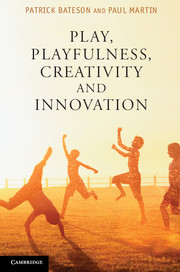Book contents
- Frontmatter
- Contents
- Advance praise
- Preface
- Acknowledgements
- 1 Introduction
- 2 The biology of play
- 3 The functions of play
- 4 Evolution and play
- 5 Creativity in humans
- 6 Animals finding novel solutions
- 7 People and organisations
- 8 Childhood play and creativity
- 9 Humour and playfulness
- 10 Dreams, drugs and creativity
- 11 Pulling the threads together
- Notes
- References
- Index
2 - The biology of play
Published online by Cambridge University Press: 05 July 2013
- Frontmatter
- Contents
- Advance praise
- Preface
- Acknowledgements
- 1 Introduction
- 2 The biology of play
- 3 The functions of play
- 4 Evolution and play
- 5 Creativity in humans
- 6 Animals finding novel solutions
- 7 People and organisations
- 8 Childhood play and creativity
- 9 Humour and playfulness
- 10 Dreams, drugs and creativity
- 11 Pulling the threads together
- Notes
- References
- Index
Summary
The definition of play has been a recurrent bugbear in the biological literature, as Robert Fagen (1981) recognised in his groundbreaking book Animal Play Behavior. Part of the problem is that human observers are all too ready to interpret other species’ behaviour in terms of their own experience. Their definitions are ostensive rather than operational – that is to say, they point to a real example of the behaviour and say: ‘That is what we mean by play’. For those scientists who are not present to be shown what is meant, the definition may be supported by verbal descriptions, drawings or videos. Such descriptions of play are often accompanied by the statement that the behaviour is not serious, in the sense that it does not apparently satisfy an immediate biological need of the individual, such as obtaining food or winning a fight.
The label ‘play’, when applied to animal behaviour, draws attention to how readily humans project onto other animals the perceptions they have of themselves and their fellow human beings. Such projection was revealed in many people’s reactions to a beautifully illustrated book called Why Cats Paint by Busch and Silver (1994), which caused a flurry of interest among art critics. The book contained paintings supposedly produced by cats. Like those by some captive chimpanzees, the cats’ artistic creations were seen as ‘joyous and full of life’. Moreover, the cats were not simply creating abstract pictures, they were said to be doing so playfully. The book attracted serious reviews in major newspapers, amazing though this may seem.
- Type
- Chapter
- Information
- Play, Playfulness, Creativity and Innovation , pp. 10 - 27Publisher: Cambridge University PressPrint publication year: 2013



